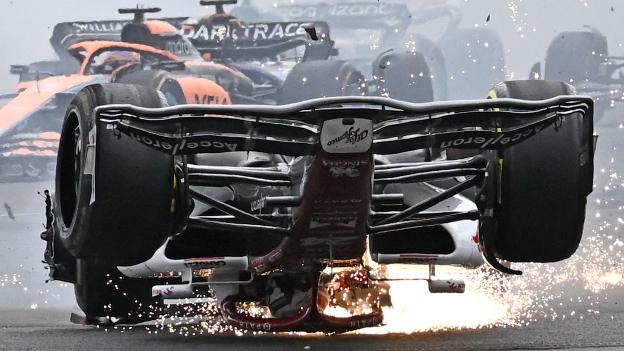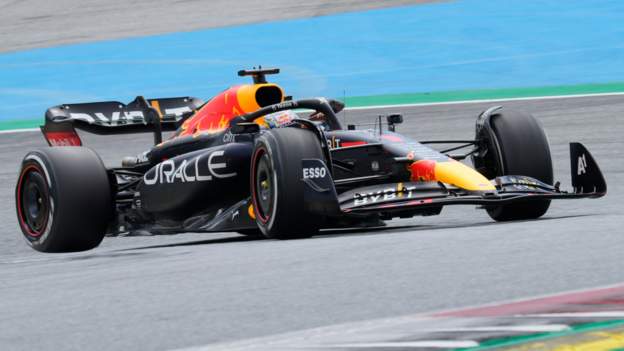Formula 1’s governing body has resisted pressure from teams to back down on its moves to limit the ‘bouncing’ of cars.
Title contenders Red Bull and Ferrari were among those to object to the FIA’s attempts to control the amount cars can demonstrate the phenomenon.
But an FIA statement said: “It is the responsibility and prerogative of the FIA to intervene on safety matters.”
The measures will come into force at the Belgian Grand Prix, which will take place from 26-28 August.
The FIA’s commitment to the topic was confirmed at a meeting of F1’s technical advisory committee on Thursday.
The governing body is to introduce a metric which will determine the maximum amount of bouncing that is permitted by each car.
Teams will have to make set-up changes if their car exceeds the limit and could face disqualification if it does so during qualifying or a race.
In addition, the FIA has taken measures to limit the flexibility of the cars’ floors after it came to the conclusion in its measurements of the cars’ bouncing in recent races that some teams had found ways to flex their floors beyond expected limits.
What is bouncing?
Bouncing is a phenomenon that has returned to F1 for the first time in 40 years this season as a result of rule changes aimed at generating closer racing.
These have changed the way the aerodynamics of the cars work and reintroduced something called ground effect, by which downforce is created by accelerating the airflow under the cars’ floors.
This has led to two different but related problems:
- Porpoising – when the airflow becomes disrupted, the car raises as downforce is lost, then lowers as the airflow stabilises, before stalling again, leading to a high-frequency vertical oscillation.
- Bouncing – where the stiffness of the suspension set-ups required to run ground effect efficiently leads to the car displaying poor ride properties over bumps.
The drivers are concerned about the safety implications of the two phenomena and at a meeting at the Azerbaijan Grand Prix last month collectively asked the FIA to intervene.
Lewis Hamilton suffered vertical loads in excess of 10G in his Mercedes during the Baku race.

Why did some teams object?
Red Bull and Ferrari were among those who said it was wrong to penalise the teams who had porpoising and bouncing under control because others did not.
Mercedes – whose car exhibited among the worst bouncing and porpoising early in the season before it began to manage the problem in recent races – were in the opposite camp.
Mercedes believes that Red Bull and Ferrari are among the teams who have found ways to make their floors flex in a manner which is within the definitions of the regulations, but outside their intent.
Red Bull team boss Christian Horner said at last weekend’s Austrian Grand Prix that such claims were “total rubbish”, adding that there were “absolutely no issues or concerns on our floor”.
The FIA said: “The reason the regulations allow such measures to be taken is precisely to allow decisions to be taken without being influenced by the competitive position each team may find themselves in.”
It said in a statement that it had taken on board the arguments made by the teams in Thursday’s meeting but said: “While the issue has been seemingly reduced in the last few races, they took place at circuits where the effect is expected to be lower than normal.
“Races where this effect is expected again to be higher will take place in the coming months.
“While the teams are understanding more and more how to control the issue, the tendency for 2023, with the cars developing more downforce, will most likely be a worsening of the effect.
“The short-term measures put in place for 2022, starting at Spa, are not considered necessarily to be the long-term solution to the problem.”
What is the FIA doing about it?

The measures coming into force in Belgium are a stiffening of the metal skid plates within the underbody ‘plank’ that defines minimum ride height, and a metric defining the amount of permitted bouncing.
The FIA says cars will “have to stay below a prescribed value during the races”.
It added: “The F1 teams will be able to use the metric already from the forthcoming race in France, in order to learn its full implications on their cars’ set-up.”
The French Grand Prix takes place from 22-24 July.
There will also be a series of rule changes for 2023 to try to control bouncing.
These include the raising of the edges of the floor and the diffuser at the back of the car, more stringent deflection tests for the floors and a more accurate sensor to quantify aerodynamic oscillation.
The meeting also discussed the heavy accident suffered by Alfa Romeo driver Zhou Guanyu at the British Grand Prix, in which his car vaulted a barrier and had its roll-hoop torn off.
For 2023, more stringent design measures will be introduced on roll-hoops, which protect the driver in roll-over accidents.


